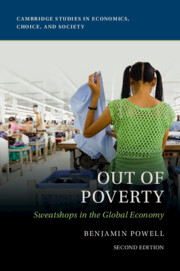Book contents
- Out of Poverty
- Cambridge Studies in Economics, Choice, and Society
- Out of Poverty
- Copyright page
- Contents
- Figures
- Tables
- Acknowledgments
- Preface
- 1 Introduction
- 2 The Anti-Sweatshop Movement
- 3 The Economics of Sweatshop Wage Determination
- 4 Don’t Cry for Me Kathie Lee
- 5 Health, Safety, and Working Conditions Laws
- 6 The Rana Plaza Disaster and Its Aftermath
- 7 Save the Children?
- 8 Is It Ethical to Buy Sweatshop Products?
- 9 A History of Sweatshops, 1780–2019
- 10 The Process of Economic Development
- 11 What Good Can Activists Do?
- 12 Conclusion
- Bibliography
- Index
1 - Introduction
Published online by Cambridge University Press: 02 January 2025
- Out of Poverty
- Cambridge Studies in Economics, Choice, and Society
- Out of Poverty
- Copyright page
- Contents
- Figures
- Tables
- Acknowledgments
- Preface
- 1 Introduction
- 2 The Anti-Sweatshop Movement
- 3 The Economics of Sweatshop Wage Determination
- 4 Don’t Cry for Me Kathie Lee
- 5 Health, Safety, and Working Conditions Laws
- 6 The Rana Plaza Disaster and Its Aftermath
- 7 Save the Children?
- 8 Is It Ethical to Buy Sweatshop Products?
- 9 A History of Sweatshops, 1780–2019
- 10 The Process of Economic Development
- 11 What Good Can Activists Do?
- 12 Conclusion
- Bibliography
- Index
Summary
This chapter introduces the economic perspective on sweatshops and some alternatives available to workers. It explains the ethical standard – the welfare of Third World sweatshop workers and other poor people in the countries where sweatshops are located – that will be used throughout the book, and it provides an overview of what will be covered in the coming chapters.
- Type
- Chapter
- Information
- Out of PovertySweatshops in the Global Economy, pp. 1 - 8Publisher: Cambridge University PressPrint publication year: 2025

